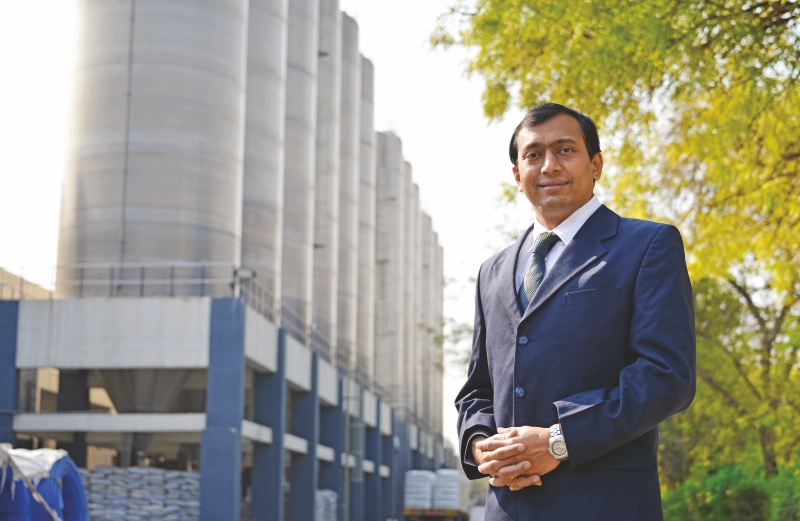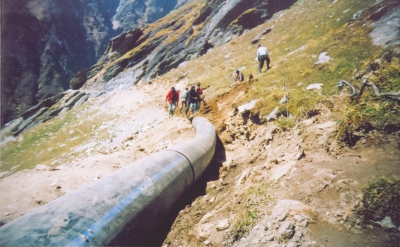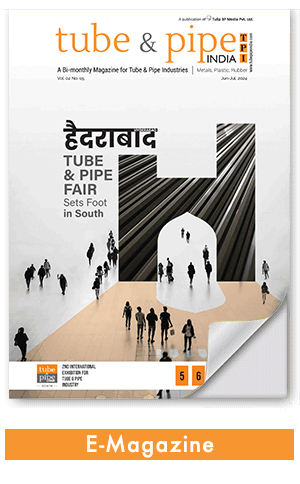
This case study deals with the water management project for agriculture at ‘Balh valley On-demand (24×7 system) Irrigation Project’ Mandi, Himachal Pradesh, India completed on turnkey basis including SCADA system implemented for a command area of 2355 ha. Himachal Pradesh is northern-western ranges of Himalaya, at elevation 350 m to 7000 m above MSL. Topography consists of hilly and valley terrain and so for any person it is very difficult to walk without help of a stick. Agriculture land holding is very small and before implementation of this project the entire agriculture was dependent on rain water only. During the summer season there is no availability of water for agriculture although water is available during the rainy season.
The Balh valley area is spread over 101 sq. km in Mandi district. The source of income for the farmer is only agriculture. For many years the Government of Himachal Pradesh made efforts to construct a canal for irrigation purposes, but was not successful because of undulated terrain and soft soil. The Government of Himachal Pradesh has taken initiative and made water available at the doors of farms by using HDPE pipes. In this paper, a case study cum salient feature of said project is highlighted and will act as a proven example where water can be made reachable at difficult terrain also for the welfare of agricultural community by using HDPE pipes.
Concept of Project
In this project various sizes of HDPE pipes (900 mm to 110 mm) & various pressure ratings of HDPE pipes, PN 4 to PN 25 (length @ 300 km) are used to deliver the water at each farm outlet point. This project was initiated in Jan 2008, water was lifted from the hydel canal and transported at various places. Water storage tanks were constructed at various places mostly at higher elevation. Taking the advantage of available terrain slope, the irrigation water is further transported to various farms by gravity.
The Balh valley on-demand irrigation project in its initial phase was planned using open channels (also called as surface gravity canal) as the main water conveyance. But considering hilly terrain the cost of cutting hills for maintaining gravity level required for channels was enormous. Also acquisition of farm-land from individual farmers for construction of open canal / channels was the main & biggest hindrance that was stopping the efforts initiated by Government of Himachal Pradesh at many levels. Hence an integrated solution is provided by Jain Irrigation Systems Ltd company by proposing underground installed pressurized network of HDPE pipes and fittings for conveyance of irrigation water. With the help of automation (SCADA system) the irrigation water is delivered to each farm-outlet to cater the irrigation needs of farmers in Balh valley area.
This project is included under Accelerated Irrigation Benefit Programmed (AIBP) of Government of INDIA. Under the scope of this Project, it is proposed to cover 2355 hectare CCA (Cultural Command Area) by the conjunctive use of surface (hydel canal) and groundwater (tube well water). The total water requirement of the Project is 37.08 cusecs.
The underground HDPE pumping main has been designed in such a way that it will always remain under pressure all the time and the lifted water is stored in tanks constructed at corresponding lift pump house in respective locality from where by pumping the water is taken to the distribution chamber, constructed at the highest point of the command area from where the irrigation-water is supplied to its respective command area by gravity as and as per the demand of farmers. This project has been entirely automated using the SCADA system, hence as per the water demand generated at farmer level, the water is lifted from the intake hydel canal (at head works), and the demand is fulfilled without any delay. This on-demand irrigation system is fulfilling and ensures the demand of farmers round the clock.
Features of Project
Considering the long life (100+ years) of HDPE pipes and advantages as easy & fast installation at difficult terrain, no leakages & no wastage of water, withstand to sub-zero temperature, no repair & no maintenance cost, no replacement cost, low capex & low opex as compared to metal pipe or concrete pipes, the HDPE has been proposed, designed, installed and working successfully.
- The project is completed in stipulated period, because of unique properties of HDPE pipes & fittings, like light weight, flexibility of pipes, easy handling, and fast installation.
- The on-demand irrigation system has been functioning perfectly for the last 11 years, due to perfect installation & use of HDPE leak-proof pipes & fittings.
- Earlier Government departments used to convey water through open canals, where @ 60% water just lost through evaporation, percolation & seepage.
- Another issue of theft of water and breakages of the canal, which was very difficult to monitor and control. Because of HDPE pipes all those issues have been solved.
- On-demand fully automatic integrated irrigation system (using SCADA system) provides assured water for the agriculture needs as and when required (24 x 7 system).
- Leak proof joints of HDPE pipes ensured ZERO leakages, thereby resulting in optimum utilization of available water.
- The area of Balh Valley (Himalayan region) is susceptible for earthquake vibrations and movements, wherein HDPE pipes can easily sustain the earthquake movements because of inherent stainability available within HDPE pipes and joints. Hence, HDPE as material of construction avoids post-earthquake damages & post-earthquake service is very much guaranteed.
- For construction of open channels carrying of civil construction material (cement, sand, steel, aggregates, boulders, brick, water etc) at an altitude of 4000 feet in hilly terrain is very expensive and time consuming hence use of light weight-flexible HDPE pipes solved all the problems.
- In the past, the Government department used to convey water for such irrigation projects through open channels, where it is necessitated purchasing the desired strip of land for construction of open channels, whilst HDPE pipe installation is underground hence there is no need to purchase land for laying the underground pipelines.
- Smaller trench size is required for installation of HDPE pipes hence natural compaction of soil is maintained using HDPE pipe. This reduces the cost of excavation and soil displacements.
- Managing on site demand for change in layout of HDPE pipes raised because of immediate constructional requirements is also possible using on-site fabricated HDPE fittings.
Also Read: Lalbaba Seamless Tubes’ Recent Developments: Udaan & New Stainless Steel Division
Advantages of Large Diameter HDPE Pipes as a Pumping Main
The project clearly demonstrates the inherent benefits and easy adaptability of HDPE pipes to adverse geo-climatic conditions. This can help engineers all over the world in selecting the best piping material for rising mains.
✔ HDPE pipes and joints resist forces generated as a result of earthquakes, landslides, soil-movements (typically observed in black-cotton soil).
✔ HDPE pipe is lightweight facilitating manual transportation of 6m pipe length and pipes in coil form on hill slopes besides easy maneuverability.
✔ HDPE pipe has a longer service life span of more than 100 years especially under varied hostile geo-climatic environmental conditions.
✔ HDPE pipe is lighter in weight, needs less time for transportation and installation, ultimately reduces the overall project time and cost.
✔ Availability of local labor for efficient transportation of pipes and equipments in hilly regions is a major problem, and the use of lightweight HDPE pipe results in savings in cost of labor.
✔ For HDPE pipe no coating/lining is required, which ultimately results in reduced operational overheads (short, medium and long term).
The above affirmative and positive results from this project paved the way for the installation of larger diameter pipelines in the most difficult and hostile hilly terrain in any corner of the world. Engineers worldwide can aid and assist users worldwide by sharing the project success.

The Balh Valley on-demand irrigation project involving installation of large diameter HDPE pipes up to 900mm OD pipes as pumping main under adverse conditions is an unique project. Many infrastructure industries worldwide will be benefited by sharing the project adventures and challenges, which helps them to identify issues and obstacles long before they become a problem while executing similar projects, and refrain its users from blindly following the old methods, traditional materials of construction for their piping needs.
Conclusions
It has been noted from the success of the project and after 11 years of operation and maintenance period, that this project is truly exceptional in registering the sustainable pioneer endeavors undertaken by Jain Irrigation Systems Limited. This effort was through the medium of HDPE pipe as a primary material of construction for rising (pumping) main, which is extremely comfortable under hostile (heavy rains/cold) weathering conditions, as well as under undaunted geographical life in that area.
The use of HDPE pipes & fittings for using in on-demand irrigation projects as pumping main over traditional use of open channel above-ground conveyance of water, where the losses of precious and depleting water resources is totally eliminated and this can facilitate engineers all over the world in justifying the deserving candidate for a special mention.










